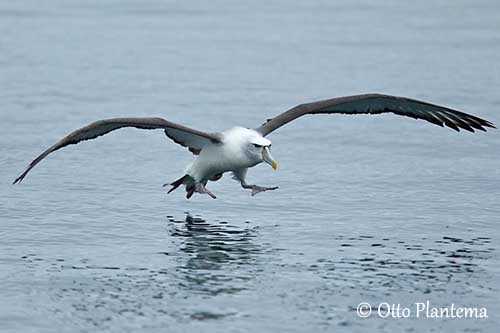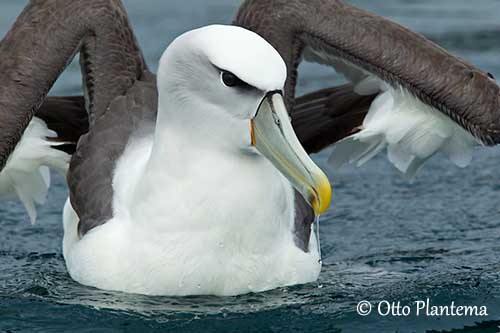
Fr: Albatros à cape blanche
Ang: Shy Albatross - White-capped Albatross
All: Weißkappenalbatros
Esp: Albatros Frentiblanco
Ita: Albatro cauto
Nd: Witkapalbatros
Sd: Gråkindad albatross
Photographers:
Ken Havard
My Bird Gallery & Flickr gallery 1 & Flickr gallery 2
Otto Plantema
Trips around the world
Simon Tan
PBase Bird galleries
Alan & Ann Tate
AA Bird Photography
Text by Nicole Bouglouan
Sources:
HANDBOOK OF THE BIRDS OF THE WORLD vol 1 by Josep del Hoyo-Andrew Elliot-Jordi Sargatal - Lynx Edicions - ISBN: 8487334105
A Complete Guide to Antarctic Wildlife by Hadoram Shirihai and Illustrated by Brett Jarrett - Edited by Guy M. Kirwan - ALUL.A Press Oy, Finland - ISBN 9519894705
Department of Sustainability, Environment, Water, Population and Communities
New Zealand bird status between 2008 and 2012
New Zealand birds and birding (Narena Olliver)
Wikipedia, the free encyclopaedia
Biodiversity Explorer – The Web of Life in Southern Africa
Bird Web (Seattle Audubon Society)
NSW - National Parks and Wildlife Service - Threatened Species Information
Shy Albatross
Thalassarche cauta
Procellariiformes Order – Diomedeidae Family
INTRODUCTION:
In the past, the Shy Albatross had three subspecies: cauta, salvini and eremita. The two latter are now full species.
However, the Shy Albatross still includes today two subspecies: cauta and steadi, but some authorities separate them into two full species, the Shy Albatross and the White-capped Albatross.
They are virtually inseparable, with only some morphological details making the difference. They are studied here as subspecies of Thalassarche cauta.
The Shy Albatross is considered Near Threatened, due to longline fishing, predation on the breeding grounds and reduced breeding range.

DESCRIPTION OF THE BIRD:
Biometrics:
Length: 90-100 cm
Wingspan: 220-256 cm
Weight: M: 3900-5100 g – F: 3200-4400 g
The adult is a medium-sized albatross with white head, underparts and underwings (where narrow dark margins are visible at all ages). A small black patch is visible where the anterior part of the leading edge joins the white body. The black wingtips are fairly small, and a large amount of white occurs at bases of primaries.
The upperparts are pale grey from hindneck to upper mantle, and become darker grey on lower mantle and back. Scapulars and upperwing are blackish-grey. Rump and uppertail-coverts are white. The tail is dark grey.
The upperparts appear browner in worn plumage.
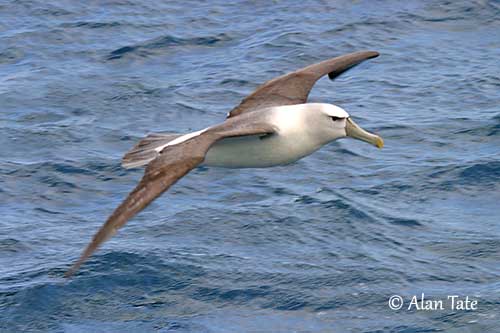
The head is white with grey tinge on ear-coverts and upper face, enhancing the pure white forehead and crown. We can see conspicuous blackish eyebrow and triangle surround, broader in the loral area and narrower behind the eye. A narrow white crescent contrasts with the dark iris at the rear of the eye.
The bill is grey, sometimes slightly tinged greenish to olive, with yellow tip and often pale yellow culmen brighter near the base, and yellow cutting edge to lower mandible. There is a narrow orange line at base of lower mandible, and a pink gape line, often invisible.
The eyes are dark brown. Legs and webbed feet are bluish-grey with pinkish tinge.
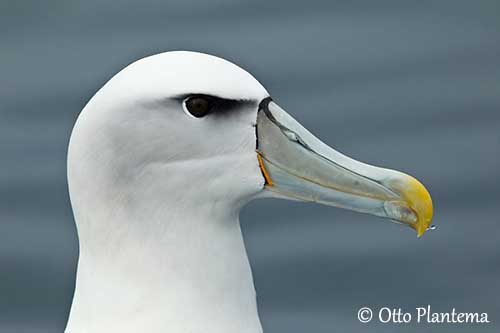
Male and female have similar plumage, but the female is globally smaller.
The juvenile resembles adults, but it has grey bill with black tip. Hindneck and neck sides are darker and browner, and may form a collar contrasting with the paler head. Face and crown are more uniform than in adults.
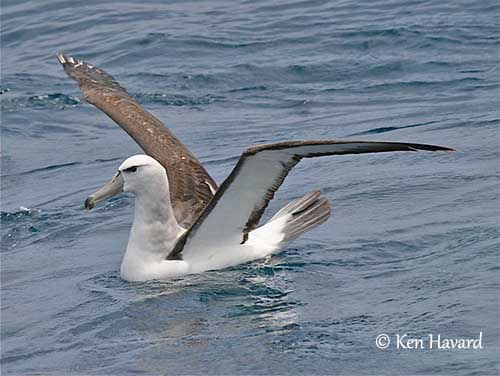
SUBSPECIES AND RANGE:
The Shy Albatross has two subspecies.
T.c. cauta occurs in South Australasian waters. It breeds on three islands, Albatross, Mewstone and Pedra Blanca, off Tasmania.
Outside breeding season, it disperses in the Southern Ocean W to South Africa and Namibia.
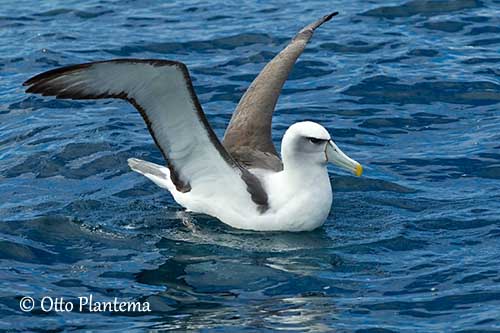
T.c. steadi breeds on Disappointment Island in Auckland group and on Bollons Island in Antipodes group.
After breeding, it disperses in the Southern Ocean E to W South America. It is commoner off South Africa, but scarce in S Atlantic and S Indian Ocean.
This race, also named White-capped Albatross when considered a full species, is slightly larger than nominate. It has paler face and less yellow on culmen.
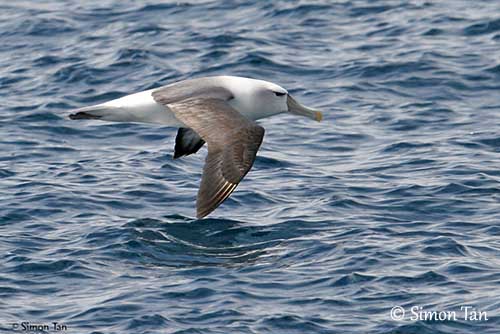
HABITAT:
The Shy Albatross is a marine bird, usually less pelagic than many other albatrosses. It can be seen over the continental shelf and often comes close inshore.
It breeds on slopes or even on flatter ground, usually in boulders with scattered vegetation. The colonies are established on offshore islands.
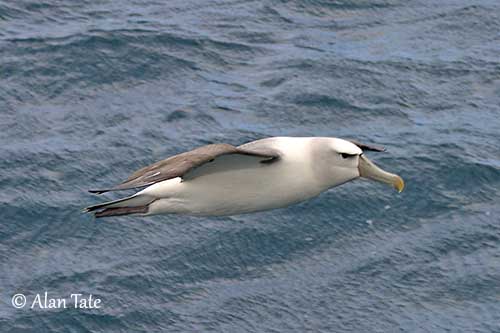
CALLS AND SONGS: SOUNDS BY XENO-CANTO
The Shy Albatross produces harsh croaking when feeding in groups at sea. During the courtship displays, several sounds are produced, including braying, croaks, cackling, wailing and “gaping display”.
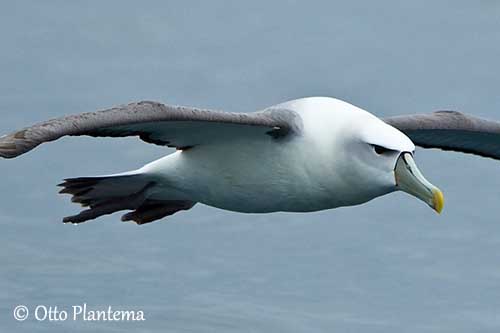
BEHAVIOUR IN THE WILD:
The Shy Albatross feeds primarily on fish and cephalopods, but it also takes molluscs, shrimps, crustaceans and barnacles. It feeds by surface-seizing and pursuit, and surface-plunging. It may perform shallow plunge from the air to underwater, during less than five seconds.
It may feed at night, mainly on cephalopods which reach the surface in the darkness.
It often forages in groups with other Procellariiformes, and follows cetaceans. Hard competition for food occurs around the fishing boats.
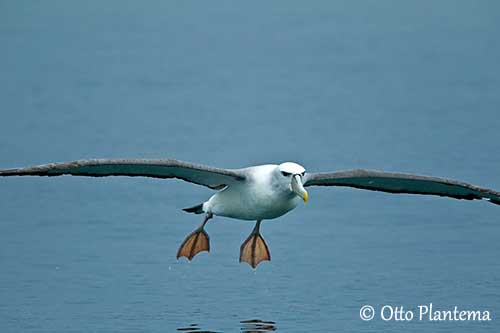
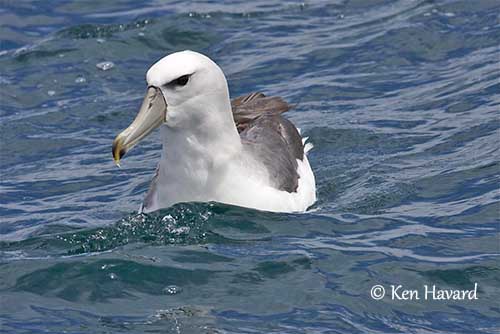
The Shy Albatross is gregarious on land and breeds colonially. It has an annual cycle of about 8 months, but they breed mostly every two years. During the breeding season, both adults are territorial and perform defence displays.
They are monogamous with long-term pair-bond. The bond is maintained and strengthened by elaborate series of courtship displays (see Diomedeidae) accompanied by calls. Both adults share all the nesting duties.
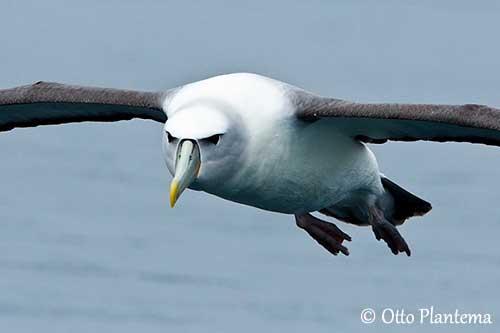
The Shy Albatross disperses in Southern Ocean, W to South Africa and Namibia after breeding.
The race steadi also disperses in Southern Ocean after breeding, E to W South America and off South Africa, but scarcely into S Atlantic and S Indian Ocean.
It has beautiful and perfect soaring flight. It flies and circles effortlessly on long, narrow, stiff wings in strong winds.
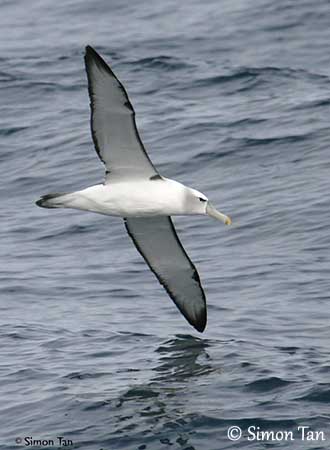
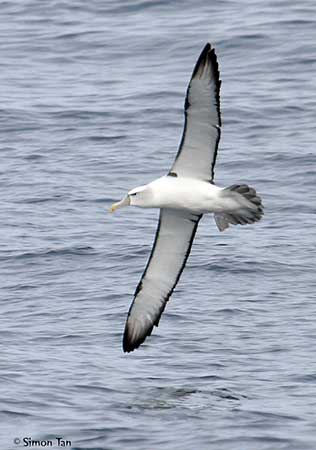
REPRODUCTION OF THIS SPECIES:
The breeding season starts in September, with the laying in December.
The Shy Albatross nests on rocky slopes with scattered vegetation, usually in sheltered crevices, on cliffs and ledges. It breeds in colonies of 6 to 500 nests, often with the Australasian Gannet.
The nest is a low truncated cone made with mud, guano, feathers, grass and roots with a central depression.
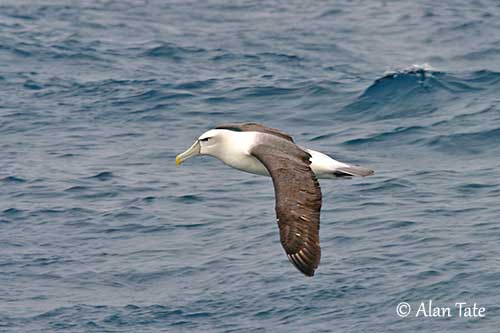
The female lays a single whitish egg with dark markings at large end. Both adults incubate during 68-75 days, with stints of 4-5 days. At hatching, the chick is covered with white down. It has dark grey bill and eyes, and pale pink legs and webbed feet.
It is brooded and guarded during 3-4 weeks, and both parents feed it every day. It fledges between 112 and 136 days after hatching. It weighs 5000 to 5700 grams.
The young male is fed ten days longer than the young female, and it grows faster. It leaves the colony in March/April.
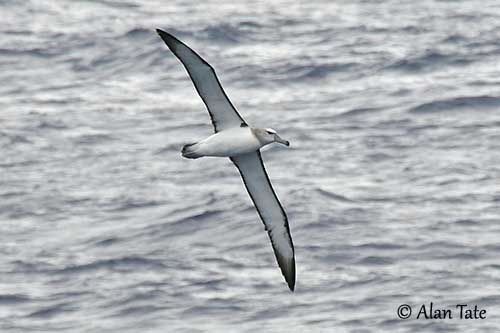
PROTECTION / THREATS / STATUS:
The Shy Albatross has reduced breeding range on three islands. At Pedra Blanca, the chicks are attacked and killed by the Australasian Gannet, involving rapid declines in chick’s populations. Extreme weather conditions also reduce the breeding success.
Adults and juveniles are caught by longline fishing while they disperse at sea after breeding. The total impact of trawl fisheries could account for 75% of mortalities.
The race T.c. steadi is affected by similar problems, with in addition, competition for food as commercial exploitation of fish and squid resources in Bass Strait could become a threat in a near future.
The population was estimated at 12,000/19,000 pairs in 2009, and 30,700 mature individuals. The global population is now estimated at 60,000/70,000 individuals.
The Shy Albatross is currently considered as Near Threatened.
